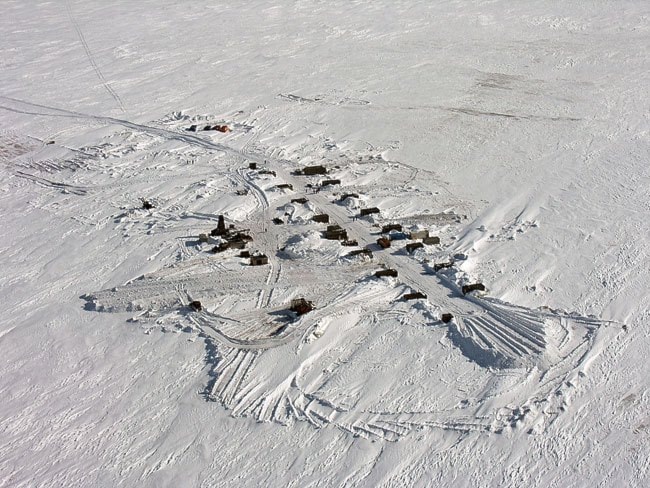In 2009 a team of international scientists braved the mid-winter chill of eastern Siberia to retrieve the longest continuous record of climate change in the Arctic.
The site was Lake El’gygytgyn, or Lake E, which was formed in the Chukotka region of northeastern Russia when a meteor struck Earth about 3.6 million years ago.
Lake E is special because the area has never been covered in glaciers, so the sediment below the lake has not been disturbed since the time of the meteor strike.
What the scientists discovered from core samples gathered there is quite astonishing.
They expected to find that the region had undergone periods of warming and cooling consistent with the global climate record, but they were shocked at just how warm the Arctic became during some “interglacial” periods, or the periods between ice ages.
“What we learned is that these super-interglacials, as we call them, they were four to five degrees warmer than normal interglacials and had twice as high precipitation,” said Martin Melles, one of the lead scientists on the project, from the University of Cologne.
The scientists also found a strong link between warming in the Arctic and Antarctic, and they suggest that the situation is comparable to the climate change we are seeing today.
“What we may see in the record of Lake El’gygytgyn is in the geological past an example of what we may face in the next few decades or centuries,” said Melles.
“So if this connect between the Arctic and Antarctic is true, then we can expect much stronger warming in the Arctic than we ever thought about.”
The scientists, who represent institutions from the United States, Germany and Russia, took an epic journey to collect this knowledge.
The initial fieldwork took place over a decade ago, during the relatively mild summers on the open waters of Lake E.
“It was a lot of fun, in that we were speaking three languages, telling jokes in three languages, swearing in three languages,” said Julie Brigham-Grette, one of the lead researchers from the University of Massachusetts Amherst.
However, the team soon realized that in order to support a drill rig big enough to collect 3.6 million years of sediment, they would have to brave the Siberian winter.
About 18 shipping containers were brought up through the Bering Strait and offloaded in the Russian town of Pevek on the East Siberian Sea.
From there they were hauled by truck and tractor a few hundred kilometres south to the research site.
EBA Engineering Consultants Ltd. out of Edmonton was hired to build an ice platform strong enough to hold a drill rig weighing 100 tonnes.
They pumped water from the lake to artificially thicken the ice surface.
The research team lived and worked through about three months of bitter winter conditions in the makeshift camp, with temperatures dropping to minus 40.
“There were some storms during the fieldwork that basically snowed everyone into their cabins,” said Brigham-Grette.
“You open your door and you just see a wall of snow.”
Despite the desolation of winter, the region rejuvenated in late April and May, when temperatures rose to just below freezing.
“We started to see large herds of caribou, which were beautiful,” said Brigham-Grette.
“The lake area is the main calving grounds for all the caribou in Chukotka, and with them came the fox and the larger animals that follow, even a bear and a wolverine. It was really fascinating to be in that part of the world and see all of the animals wake up from the winter hibernation and come alive.”
While Siberia may feel like a world away, its history is deeply connected to that of the Yukon.
The eastern parts of Russia, Alaska and much of the Yukon are part of the ancient continent of Beringia, linked by a land bridge when sea levels dropped during ice ages.
Beringia’s dry climate meant that glaciers did not form there, and the landscape was dominated by hardy grasses and large mammals, including the fabled mammoth.
We can think of the Alaska/Yukon region and the Russian region as conjoined twins who have been separated, said Brigham-Grette.
The research at Lake E offers clues to the future of the Arctic in a warming world.
“What it means is that with much smaller changes in global temperature, the Arctic may actually warm a lot more than we expected,” said Brigham-Grette.
“And climate models today do not capture polar amplification very well. They do show the Arctic getting warmer than the rest of the world, but it may be that it gets a lot warmer than we think.”
Northerners should not rest easy knowing that the Arctic has experienced periods of extreme warming in the past.
Past cycles of warming happened over thousands of years and had to do with Earth’s changing orbit around the sun, whereas the current warming trend has occurred over less than 100 years, and is due to the rapidly increasing levels of carbon dioxide in the atmosphere, said Brigham-Grette.
“The speed of change is unprecedented in historical and geological time,” said Melles.
“Even in the slower changes in the past we had extinctions of species, which help us geologists now to date our records, but this is definitely not what we can cope with as mankind.”
Contact Jacqueline Ronson at
jronson@yukon-news.com
